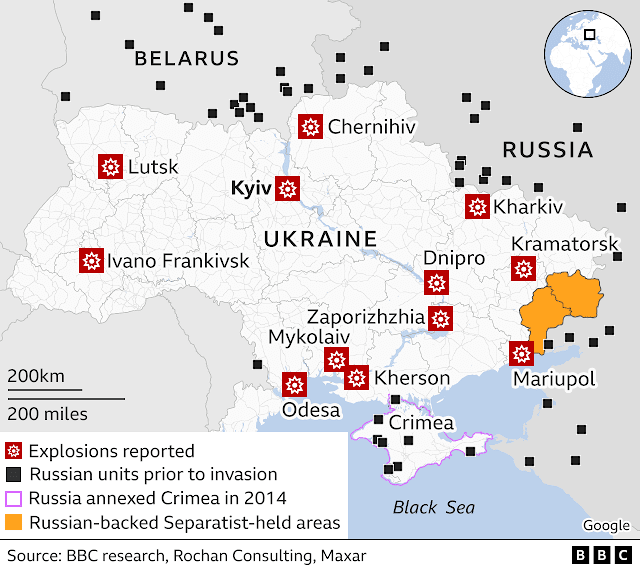TOPIC: The United States Ups Weapon Deliveries
As the worlds biggest superpower, a historical rival of Russia and a flagbearer of democratic states, it was never in question that the United States would support Ukraine following Putin's invasion. However, what has perhaps came as a surprise to Moscow and other onlookers, is the scale of US military aid.
Money, Ammunition, Javelin's
Since the Russian invasion on 24 February, the US has sent more than 3$ billion in military aid to Ukraine. On Thursday, Joe Biden announced a further $800 million of military support, whilst banning all Russian-flagged ships from entering US ports. The latest package is set to include heavier weapons, including heavy artillery, howitzers and tactical drones. The howitzers are special type of artillery piece that fires shells at high trajectories (very useful in targeting Russian support columns and logistics) and are numbered in the dozens for the latest delivery. Accompanying these assets are 144,000 rounds of ammunition as well as tactical drones. President Biden stated that these deliveries were in recognition of the changing shape of the war. He cited the shift in Russian attacks away from Kyiv and towards the flatter, less urban, Donbass region in the east as the reason behind now delivering the heavier pieces of weaponry President Zelenskyy has long requested. Previously, US support has included body armour, helmets, assault rifles, armoured vehicles, radar systems and helicopters. Hundreds of 'Switchblade' drones have also been sent, which are designed to crash in to enemy targets before exploding, in order to cause maximum damage. Formerly, the US has been reluctant to provide these types of weapons, stating the Ukrainian militaries unfamiliarity with them as their reason not to provide them. However, Pentagon spokesman John Kirby recently confirmed that a "small number" of Ukrainian troops will be trained on how to use these US designed systems. In addition to the Switchblade, 'ghost-drones' are also being provided, with Mr Kirby stating these drones were "rapidly developed by the Air Force in response specifically to Ukrainian requirements."
 |
| Lightweight 150mm Howitzer Systems. Image Credit: US Army. |
Yet despite all of the new innovative American weapon systems now on display in Ukraine, it has been its tried and tested anti-air and anti-tank weapons that have proven to be the most effective. The Javelin, a US made anti-tank, 'over the shoulder' launcher, has proven to be extremely effective in destroying Russian armour. In the initial days of the invasion, huge columns of mechanised Russian forces rolled predictably down main roads towards their objectives, making perfect targets for the Javelins. Equally, if not more effective has been the British alternative, the Next generation Light Anti-tank Weapon, or NLAW, for short. The NLAWs are lighter and cheaper than the Javelin, being used once over the shoulder to destroy a target before being discarded. All told, these weapons have seemed to been put to good use in Ukraine. Ukrainian officials claim that over 800 Russian tanks and 2,000 other Russian vehicles have been destroyed in the nearly two months of conflict.
Yet tanks and mechanised columns are not the only problem Ukraine has had to deal with, with the Russian air force proving equally problematic. As a result, the US and its allies have supplied nearly 25,000 anti-aircraft weapons by the first week of April. Of these, it is the 'Stinger' that has been most prevalent. Used to target low-flying helicopters or aircraft up to 3,800 metres, the Stinger has a history of halting Russian aggression, having been employed extensively by the Mujahedeen against Russian aircraft and helicopters during the Soviet invasion and occupation. Nonetheless, the limitation of the 'Stinger' comes in its range, which many Russian bombers have remained above. One solution to this dilemma, has been Slovakia sending Ukraine S-300 anti-aircraft missiles, which are designed to strike targets at higher altitudes, in exchange for US forces using its patriot missile systems to defend Slovakia. Though this is a start, more will be needed to slow the Russian assault from the air.
 |
| The Javelin anti-tank weapon in Use. Image Credit: US Army. |
A Long Path Ahead
The west has proven highly united in its delivery of aid to Ukraine. By the end, it may have proved decisive. But for now, Ukraine needs more, particularly more heavy weapons if it is ever to regain the territory that Russia has seized and held on to since the conflict began. Tanks are a particular concern, which the US has proved reluctant to provide, stating the Ukrainians unfamiliarity with the equipment, but perhaps also fearing encouraging further escalation. In a recent move that may urge the US forward, the British announced that they would be sending Poland some of its fearsome Challenger 2, Main Battle Tanks, so that Poland can then deliver its arsenal of T-72 tanks to Ukraine. The other key area of concern will be aircraft. Previously, plans to supply Ukraine with modern fighters have floundered, with similar concerns to those around tanks being cited. However, the west have provided spare parts, which have allowed the outnumbered Ukrainian air force to stay afloat. On April 20, a US official stated that Ukraine now had 20 more aircraft than when the conflict began as a result of the supply of spare parts. Whether this is the case or not, Kyiv will need more than spare parts if it is to emerge victorious in the Battle for the Donbas.


Comments
Post a Comment